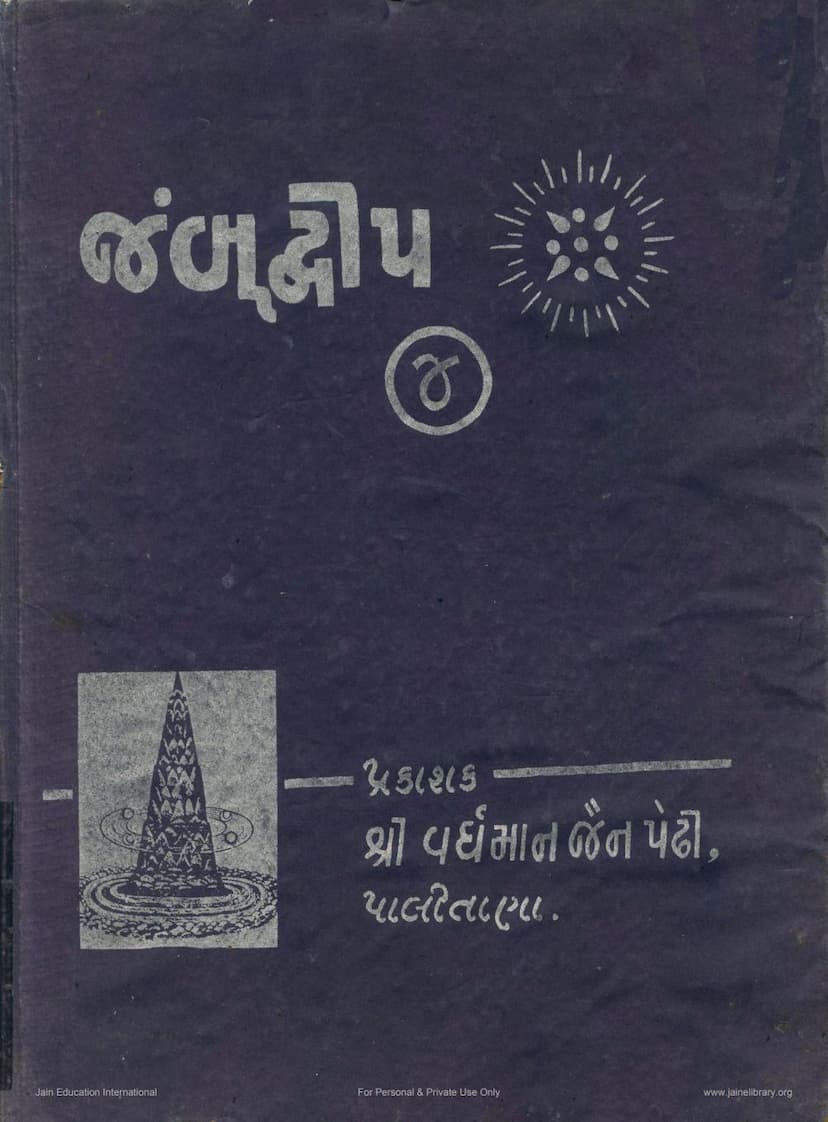Jambudwip Part 04
Added to library: September 2, 2025

Summary
This is a summary of the Jain text "Jambudwip Part 04" by Vardhaman Jain Pedhi, based on the provided pages:
Overall Context:
This volume appears to be part of a larger series focused on "Jambudvipa," a significant concept in Jain cosmology representing the central continent of the universe. The text is published by Vardhaman Jain Pedhi, Palitana. The volume contains a collection of essays and discussions by various scholars, covering topics related to Jain philosophy, cosmology, astronomy, history, and scientific inquiry, with a particular emphasis on re-examining established scientific theories from a Jain perspective.
Key Themes and Content:
- Re-evaluation of Scientific Theories: A significant portion of the text challenges modern scientific understandings of the Earth's shape, rotation, and celestial mechanics. Several articles, notably those by D.P. Chaudhary and Dr. Rudradev Tripathi, present experiments and arguments questioning the spherical nature of the Earth and the concept of gravity. They propose that the Earth's surface is flat and that phenomena attributed to Earth's rotation and gravity can be explained by other principles or are based on flawed observations and instruments.
- Jain Cosmology and Astronomy: The text delves into Jain cosmological models, particularly the structure of Jambudvipa. Articles by Rati Lal Chhota Lal Purohit and Muni Nandighoshvijayji Maharaj meticulously describe the dimensions of continents, oceans, mountains, rivers, and celestial bodies as per Jain scriptures. These descriptions are presented with detailed measurements in "Yojana" (a unit of length) and aim to provide a comprehensive picture of the Jain universe.
- Jain Chronology and "Kalchakra": Muni Nandighoshvijayji's article, "Jain Kalchakra aur Kaimik Calendar," draws parallels between Jain concepts of time cycles (Kalchakra) and modern scientific theories like the Big Bang. It also presents the Jaina chronological framework, highlighting the cyclical nature of time and the progression through different eras (Aras) and their impact on human life and the environment. The text attempts to compare Jain time scales with modern scientific estimations like the Cosmic Calendar.
- Historical and Cultural Influence of Jainism: An article by R. Narayanalal M. Kansara and others traces the historical spread of Indian culture, including Jainism, to various parts of the world, from Southeast Asia to the West. It highlights the significant contributions of Indian civilization to art, architecture, philosophy, and language in different regions.
- Critique of Modern Science and Revival of Traditional Knowledge: The publication, particularly through articles like "Kya Apollo Yan Chand par Pahuncha?" by Muni Abhay Sagarji, and the sections questioning gravity and Earth's shape, strongly advocates for re-evaluating modern scientific claims and rediscovering the validity of ancient Jain knowledge. The authors suggest that modern science, while advanced in material aspects, lacks the spiritual depth and holistic understanding found in Jain scriptures.
- Supernatural Abilities and Spiritual Practices: An article by Swami Alkanandji, discussing Swami Arvind's experiences, touches upon extraordinary yogic powers, including inter-planetary travel and communication with extraterrestrial beings. This section emphasizes the potential of advanced spiritual practices within Jainism to achieve feats beyond current scientific comprehension.
- Jainism's Originality and Independence: Several articles throughout the volume aim to establish Jainism as an independent and ancient religion, distinct from Brahmanism and Buddhism, citing historical and scholarly evidence.
- Detailed Description of Jain Measures of Length: An extensive article by N.L. Jain analyzes the units of length described in various Jain canons, highlighting inconsistencies and proposing a standardized approach. It discusses the concept of "Pradesa" (space point) as the fundamental unit and compares different measurement systems.
- The Eastern Astronomy: This section by Damodar Jivaraj Kotak presents a critique of modern astronomical conclusions, proposing alternative explanations for celestial phenomena based on "Eastern Astronomy." The author challenges established theories about the solar system, planetary movements, and the sun's and moon's characteristics.
- "Pritvi Ka Aakar Kya Hai?": This article by Dr. Rudradev Tripathi critiques the scientific evidence for a spherical Earth, presenting experiments and arguments that suggest a flat Earth.
- "Hindu Dharma Ki Pratishtha": This article by Shukdev Sharan Brahmachari discusses the historical vastness of India and the perceived decline in adherence to Vedic traditions, urging for the revival of Hindu values.
- "Bharat ka Vistar Kitna?": This article also touches upon the historical and geographical extent of India, lamenting the loss of traditional understanding.
Key Publishers and Contributors:
- Publisher: Vardhaman Jain Pedhi, Palitana.
- Notable Contributors/Editors: Dr. Rudradev Tripathi (Delhi), Dr. Nemichand Jain (Indore), Narayanalal M. Kansara (Ahmedabad), Dr. Prahladbhai G. Patel (Wadnagar), Dr. Jitubhai P. Shah (Palanpur), Pt. Ratilal Ch. Desi (Ahmedabad), Muni Sri Abhay Sagarji, Muni Sri Nirupam Sagarji, Muni Sri Kalyan Sagarji, Muni Sri Hemchandra Sagarji, Muni Sri Ravindra Sagarji, Muni Sri Punyashakhar Sagarji, and others from various religious and academic institutions.
Overall Tone and Purpose:
The publication appears to be driven by a mission to revive and re-establish the authority of Jain scriptures and traditional Indian knowledge in the face of modern scientific dominance. It questions established scientific paradigms and presents Jain cosmological and astronomical accounts as potentially more accurate or at least worthy of serious consideration. The tone is assertive in its critique of modern science and advocates for a deeper understanding of ancient wisdom.